we-make-money-not-art link: more notes
more notes from regine here.
documentation blog
In the Mobile Music community town meeting we discussed how the participants experienced the workshop and what the differences with previous workshops were, but also what the everyone thought Mobile Music to be.
----
Some comments on the workshop:
Bart: Need for a theme to connect different subjects and hands-on sessions.
Lalya: might help if there would have been brainstorming sessions.
Kristina: focus is maybe too much on technologies and phones as opposed to music.
Kristina suggests that we could have an audience - let's say 30 kids.
Frauke remembers that a lot of projects were about walking
Dan Wilcox : easier to use a mobile phone when you're walking
Atau: is it because we're in Europe?
Lalya remembers projects in Canada that we're based on cycling
When you walk you can pay more attention to your surroundings
Yolande: open session on sunday had an audience - a good way to start the workshop.
Atau: The participants we're the audience in Cathy's performance.
Each workshop has been very different - no general theme has emerged.
The workshop has grown only a little (3 & 4 are about the same size)- it's kept small on purpose.
Is the community growing or shrinking? The community is not necessarily growing but the type of participants has shifted - from more tech-oriented to more musical.
Anna Dumitriu remarked that the workshop had a real 'make' feel to it - really hands-on.
Atau: 2 years ago there was no hands-on at all...
The mobile music workshop is not quite there yet to be taken up into the ACM library - it took NIME 6 years.
Adding another category of submission which is not necesarily very academic but more like a (free) position paper might be a good addition to the workshop. This category should not necessarily be published.
More performances and demo's would be a good addition as well.
The workshop could be more open - more installations and demo's - inviting a bigger crowd such as kids. This would then require a different festival-like structure.
----
Then the discussion continued trying to find a definition for Mobile Music:
There has always been mobile music - the workshop focusses mostly on the technology part of mobile music. The word mobile in mobile music is misleading because it relates to a mobile phone. Do we need a new term? locative audio?
What is Mobile Music
- using a phone? is a phone important?
- is it technology driven
- is it participatory/collaborative?
- is it a performance?
- does there have to be an audience?
Are we too early to define what is mobile music - focus on thought-provoking strong projects and let the collage of them be the definition of mobile music.
Frauke: Should Mobile Music be an intervention - how do public and private play a part?
----
And there were some comments on Mobile Music Workshop communication:
Preparation is very formal - ACM format might be a hindrance - in most cases an abstract is sufficient for other workshops. Participants are not all used to writing papers.
Not every community was addressed - the call did not reach everyone.
Communication - no press was invited intentionally apart form Amsterdam Weekly. Should a workshop like this be on the local news?
Posted by Ronald Lenz at 22:00 0 comments
During the hands-on session at Waag I had a go at MobiTracer together with one other participant (see www.geotracing.com). You take out a mobile phone connected to a small wireless GPS device on a walk through the city. On the way you can stop and take pictures or record sound and immediately upload your media to the geotracing server. On your return you can then look at a map of your walk (trace on Google maps) and there are little coloured points on your trace where you uploaded your media. You can click on the media spots, or re-plot your whole trace with the media playing alongside.
While walking around you can also scan your surroundings for media traces left behind by other people. We were so busy recording our own sounds, taking pictures and uploading them that we actually forgot to scan for other people's traces. The constant but slow beeping indicating a working GPS connection was very reassuring and was a great way of conveying this information as we didn't have to stare at the screen while walking. Unfortunately it was raining so we didn't go too long in order to safe the equipment.
We were taking pictures of the walk...but they are now on the server. And we didn't take any other ones with our own cameras. So much documentation, and all in different places. So you'll have to look them up on www.geotracing.com.
Accidentally drew the trace of an M .... easy.....
Posted by Ronald Lenz at 14:46 0 comments
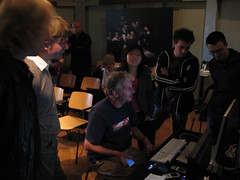
IMG_7442.JPG
Originally uploaded by mobilemusicworkshop.
Posted by Ronald Lenz at 14:23 0 comments
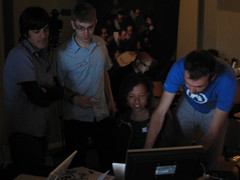
IMG_7454.JPG
Originally uploaded by mobilemusicworkshop.
Posted by Ronald Lenz at 14:22 0 comments
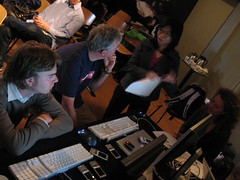
Geotracing workshop
Originally uploaded by mobilemusicworkshop.
Posted by Ronald Lenz at 14:21 0 comments
- plug the arduino board in and download the software and drivers from arduino.cc
- install driver, restart, get LED and plug into 13 and GND
- choose: tools/serial/tty-usb-serial
- choose: tools/microcontroller/choose 8 or 16
- find example code in scketchbook/examples/blink-led
- press button on board and choose upload
- et voila *blinking*
- look through the code - change the delays
- no short circuit if you want your computer to live
- follow the course in the handbook...
---
idea: using toys as buttons [not quite circuit bending]
---
build your own touch sensor:
it works through 10 cm of stuff
---
plug and play sensors from phidget
Posted by k at 14:01 0 comments
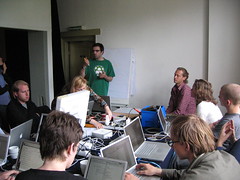
Arduino physical computing workshop
Originally uploaded by mobilemusicworkshop.
Posted by Ronald Lenz at 13:51 0 comments
some notes from descriptions of installations:
a gps receiver is fixed in space yet the signal keeps changing. reading a satellite is a mobile situation. you are inferring your position from a moving object. the stationary gps device thinks it is moving and it infers the direction it is supposedly moving in. it is traveling through an imaginary space of position error.
using a gps is believing you know where you are and getting lost. this data is changing our relation to the landscape. it gives us a sense of false security. how do we understand where we are? you, as a person, is mobile and the gps data infers that static objects like buildings are also mobile.
what does the word mobile actually mean? is the entire system actually floating?
the history of astronomy is the beginning of navigation: positions is derived through the the comparing of spinning motions. satellites spinning in orbit are part of this navigational system and through gps reflects back on us its data and inaccuracies.
coastal navigation: the sextant and the chronometer allows you to work out where you are. you can determine your height above and below equator. the light house declaring its identity through different flashing sequences.
images of tracing along the coast of brittany. the moving tract of a boat on anchor. the anchor point is somewhere in the center of the trace. google earth taking pictures as events passed. the pull of the wind on a windy day. all this data is translated into sound. the sea disrupts your sense of balance...
asking the strawberry seller for directions.
Posted by k at 11:31 0 comments
Location all day: WAAG Nieuwmarkt
9.30 –10.00 Morning coffee
10.00 - 11.30 Papers (registered participants only):
• 10.00 Isabella van Elferen, Imar de Vries / Floating Fabulousness: Representation, Performativity and Identity in Musical Ringtones
• 10.45 Yolande Harris / Taking Soundings - Investigating Coastal Navigations and Orientations in Sound
11.30 - 15.00 Hands-on [lunch break flexible] (registered participants only):
• Geotracing (Just van den Broecke)
• Arduino (Bas van Abel - Waag Society and Ubi de Feo - TwoDotOne)
• KeyWorx Live (Lodewijk Loos - Waag Society)
15.00 - 16.00 Mobile music community town meeting (registered participants only)
16.00 - 18.00 Closing sessions (open to the public):
• 16.00 Critiques and comments: Paul Keller
• 17.00 Closing keynote address: Régine Debatty
20.30 PARTY
Posted by k at 10:00 0 comments
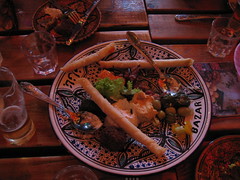
dinner @ Bazar
Originally uploaded by mobilemusicworkshop.
Posted by Ronald Lenz at 18:00 0 comments

dinner @ Bazar
Originally uploaded by mobilemusicworkshop.
Posted by Ronald Lenz at 18:00 0 comments
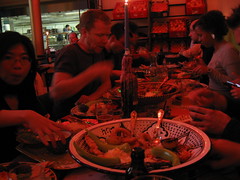
dinner @ Bazar
Originally uploaded by mobilemusicworkshop.
Posted by Ronald Lenz at 18:00 0 comments
The Hands-on session 'Developing Python for S60 applications for Mobile Phones' by Jürgen Scheible started with an introduction to some of the presenter's projects that are related to mobile music:
MobiLenin http://www.mobilenin.com/
The MobiLenin system is a hybrid interface for mobile group interaction combining the complementary strengths of a public display and a personal mobile phone to provide enriched entertaining and social experiences. The MobiLenin system allows a group of people to interact with an interactive music video on a large public display using their personal mobile phone.
Storymeshup
This is a game style project with 180 students taking pictures in New York as triggered by stories submitted online. collaborative story-telling, picture taking, pervasive gaming project. Jurgen will present a paper on this in Toronto at the Pervasive Computing conference in a few weeks.
Next we were introduced to the Python basics, each got a S60 phone and connected it to our laptops.
Mith Jurgen's instructions and some pre-arranged files he provides we were soon rocking out mobile phones trying out MIDI, sound recording and connecting up to MAX/MSP. We treated ourselves with a sponetenous Jam session with our brand new scripts.
After not having done any programming for years the satisfaction of the most simple script working makes me smile! That was easy! (Ok, the connecting to MAX/MSP was a bit of a challenge after only two hours of Python ever...)
Posted by Ronald Lenz at 16:57 0 comments
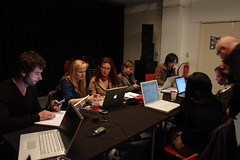
hands-on: python for Nokia s60
Originally uploaded by mobilemusicworkshop.
Posted by Ronald Lenz at 14:29 0 comments

hands-on: python for Nokia s60
Originally uploaded by mobilemusicworkshop.
Posted by Ronald Lenz at 14:28 0 comments

hands-on: python for Nokia s60
Originally uploaded by mobilemusicworkshop.
Posted by Ronald Lenz at 14:28 0 comments
These notes mainly focus on Atau's previous projects, for more detail regarding the Compass, please refer to the proceedings that will be online soon. Over the last years Atau has been aiming to replace sensors with mobile phones in his work to enable participants to cruise around in urban environment and use the mobile phone as interface for music.
Malleable Mobile Music was presented at the first mobile music workshop edition in 2004. It draws on both social and geographical context awareness: personal geographical context of user and community context of the group. The project was a demo focussing on thinking about music. Listening and playing becomes mixed up and it was key that also non-musican players would enjoy it.
In 2006 he developed a new project in collaboration with Petra Gemeinbroek, called net_derive. This project is using real mobiles and real gps, has been exhibited at a Sony exhibition in 2006, 50 people experienced it, 4 at a time and the project is documented in the NIME 2006 proceedings. The device is a white scarf wearable computing object. The artists needed three mobile phones to make it work, all housed in the scarf. net_derive explores the tension between the urban environment and the gallery space as a dynamic of group walking around in town is connected to the gallery space.
In general, one of the main problems while developing mobile music projects are the highly controlled networks, very different to developing for the Internet.
The Compass is the most recent project by Atau Tanaka, in collaboration with Guillaume Valadon and Christophe Berger. One possible scenario of use is geotaging songs and compass will point you in that direction. This project is using contacts form the address book as oposed to working with strangers in large public space. Compass is building a social network from the address books of various phones and retrieving the geographic location of friends. The compass server can store locations, friends and audio and connect them in various ways. For example, the mobile phone is pointing you in the direction of a friend, once you are in close proximity the playlist of the friend is retrieved via Wifi, and next, a selected song is retrieved via wifi as well.
Posted by Ronald Lenz at 12:17 0 comments
Martin and Laura have been collaborating on the seven mile boots (http://randomseed.org/sevenmileboots/)
He is presenting some background of the use of bull horns as political device and of the musical and artistic use of the devices, starting with the Futurists who used the bullhorn as icon to work against the musical establishment. One other early project worked worked with compressed air and was one of the loudest music devices ever invented until then.It was hooked up to several instruments, like a bass, to amplify the sound of the instrument. In other artistic examples the bull horn is often more important as statement than as amplification device.
More recent examples of using bull horns in art and music include:
- Benoit maubrey pieces
- 'exploded monologues' by troika from London (microphones in gas mask, controler sets direction of speakers)
- 'tool for armchair activists' by troika, (that was done before the introduction of speaking cctv)
- remote controlled car playing he sample with little bull horn
- acoustic space gun by Mark Bain
In Tratti (means funnel in Finnish) the sound of a mobile phone is amplified by horn speaker. Michael classifies the projects as device art, where the picking of the physical material and playfulness are key elements. Depending on the colour the mobile phone camera is picking up the following audio operations are executed: record, silence, faster, reverse.
The authors stress that working with a mobile phone is often fighting against the device for the developer and proprietary hard- software was slowing down the development a lot. Martin talked about some aspects of the mobile phone and mobile phone culture that are addressed in the piece, the talking and the listening: people are talking everywhere and you are frequently forced to overhear conversations of strangers. Tratti makes two key aspects of mobile phone visible: the speakers and camera are enlarged.
Future plans include a collaborative version where different Trattis can exchange sounds by facing each other, to exchange by joining up beelies.
In the discussion, the focus was on children, problems of development and health issues:
- One discussant was asking for more art for kids on media art festivals, as thay are now growing up with technology, e.g. mobile phones. Kristina suggesting to include kids in the process of designing interaction. One idea for evaluating this type of projects is not to tell the testers the rules. often leading to the kids finding interesting grey areas and they know what is fun and what is boring.
- The technical part of the discussion revolved around the various problems of developing for mobile phones. Gum stick is proposed as alternative platform to solve something of the technical problems.
- Another issue arising are the health issues of mobile phones, especially as children are using it. For Tratti the phones are in offline mode, so this is not an issue.
- Finally, Kristina suggests that the mobile phone has become a device with an identity crisis as it is not optimised to do anything in particular anymore, but rather does a lot of things unsatisfactory.
Posted by k at 11:00 0 comments
read regine's notes from michel waisvisz's keynote here.
Posted by k at 10:41 0 comments

michel waisvisz
Originally uploaded by mobilemusicworkshop.
Posted by Ronald Lenz at 10:30 0 comments

michel waisvisz
Originally uploaded by mobilemusicworkshop.
Posted by Ronald Lenz at 10:30 0 comments
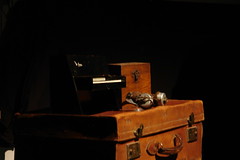
michel waisvisz
Originally uploaded by mobilemusicworkshop.
Posted by Ronald Lenz at 10:30 0 comments
Location all day: STEIM - Entrance Achtergracht 19
9.30 –10.00 Morning coffee
10.00 Keynote: Michel Waisvisz
11.00 - 12.30 Papers:
• 11.00 Laura Beloff, Martin Pichlmair / TRATTI - A Noise Maker for Children
• 11.45 Atau Tanaka, Guillaume Valadon and Christophe Berger / Social Mobile Music Navigation Using The Compass
12.30 - 14.00 Lunch break
14.30 - 18.00 Python Programming for Symbian Series 60 (Jurgen Scheible)
18.00 Drinks at STEIM Dinner at 19h at Bazar, Albert Cuypstraat
Posted by k at 10:00 0 comments
review of sunday's performances.
Posted by k at 22:54 0 comments

TokTek - Tom Verbruggen
Originally uploaded by mobilemusicworkshop.
Posted by Ronald Lenz at 17:00 0 comments
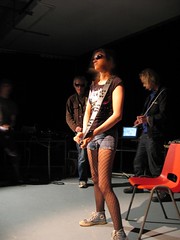
The HandyDandy
Originally uploaded by mobilemusicworkshop.
Posted by Ronald Lenz at 16:30 0 comments
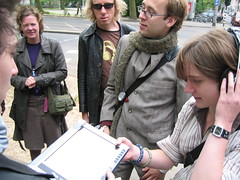
Bernhard Garnicnig, Gottfried Haider / Craving, a Spatial Audio Narrative
Originally uploaded by mobilemusicworkshop.
Posted by Ronald Lenz at 16:00 5 comments
Two projects presented at the Mobile Music Workshop paper session yesterday were related to graffiti culture.
Audio Bombing, by Mike Fleming, Kang Chang and Kyle Millns from the University of Illinois at Urbana-Champaign, uses magnetic audio tape as its medium. Here's how the system should work: after having recorded on a cassette any information you want, you remove the tape and cut out the segments to be used. Then take your tape segments and go tag whatever you want in urban space. You can listen to the tag by running an augmented playhead spray over the magnetic tape.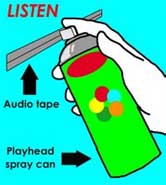
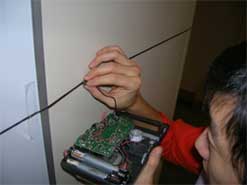
Since the graffiti is less visually obstrusive (a thin black strip), it can infiltrate spaces traditional graffiti can not such as office buildings, under tables, elevators, schools, coffee shops, etc.
The prototype consists of a hacked cassette player. The casing was removed, the play head dismantled from the circuit board to allow it to function externally.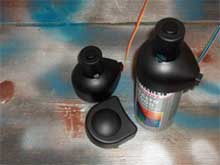 The second project dealing with graffiti and sound is Chia-Ying Lee's Sonic Graffiti: Spraying and Remixing Music on the Street. The system enables artists to create and geo-tag music in the urban space with real spray cans. A sound cap has to be snapped on the top of spray cans to spray out sounds and manipulate sound with gestures. A controller is used for listening to the music with earphones when creating, and positioning sounds. A recording part collects sound samples from the city, or records vocal performances.
The second project dealing with graffiti and sound is Chia-Ying Lee's Sonic Graffiti: Spraying and Remixing Music on the Street. The system enables artists to create and geo-tag music in the urban space with real spray cans. A sound cap has to be snapped on the top of spray cans to spray out sounds and manipulate sound with gestures. A controller is used for listening to the music with earphones when creating, and positioning sounds. A recording part collects sound samples from the city, or records vocal performances.
The guys from Audio Bombing were not arrived at STEIM yesterday when i looked for them so i don't know how far they are in the implementation of their project. Chia-Ying Lee was there and explained me that she is going to do a trial of her tagging system at the end of June in Taipei.
Posted by regine at 15:42 0 comments
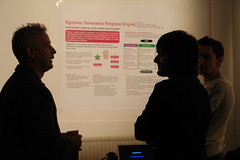
poster session
Originally uploaded by mobilemusicworkshop.
Posted by Ronald Lenz at 15:00 0 comments
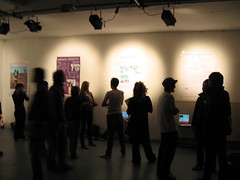
STEIM Studio 3
Originally uploaded by mobilemusicworkshop.
Posted by Ronald Lenz at 15:00 0 comments
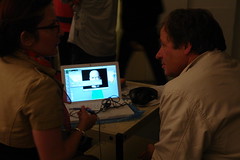
poster session
Originally uploaded by mobilemusicworkshop.
Posted by Ronald Lenz at 15:00 0 comments
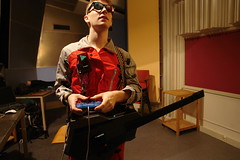
dan wilcox
Originally uploaded by mobilemusicworkshop.
Posted by Ronald Lenz at 15:00 0 comments

poster session
Originally uploaded by mobilemusicworkshop.
Posted by Ronald Lenz at 15:00 0 comments
post on the pocket gamelan project.
Posted by k at 14:52 0 comments
Location: STEIM - Entrance Utrechtsedwarsstraat 134
14.00 - 17.00 Registration desk open at STEIM
14.30 - 17.00 Demos and posters Demos
17.00 PERFORMANCES
• The Handydandy
• TokTek (Tom Verbruggen)
Posted by k at 14:40 0 comments
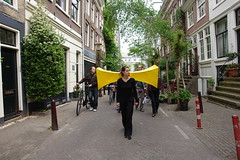
cathy van eck
Originally uploaded by mobilemusicworkshop.
Posted by Ronald Lenz at 14:32 0 comments
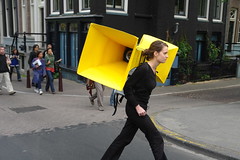
cathy van eck
Originally uploaded by mobilemusicworkshop.
Posted by Ronald Lenz at 14:32 0 comments
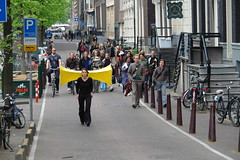
cathy van eck
Originally uploaded by mobilemusicworkshop.
Posted by Ronald Lenz at 14:32 0 comments
sound as a frame to a landscape
we make assumption of iPod bubble - isolation of headphones
how to come together to molecules?
public sphere - the feeling of connectidness
movement as mediation
generating meaning
Landscape
Romantic era:
Manifest destiny - controlled landscape
intoxicating landscape
fear of solitude/desire for individualism
paradox like paradox of the submlime
Post industrial landscape - fear, anxiety
before: VR - escape
cyborg body as a figure in the landscape
what do we look like?
We become the material of mobile ad-hoc networks
place as 1st person experience - phenomelogical
hertzian - abstract w/ respect to the objectiveness of visual
Yoho - memorial - to what? nonverbal?
Drift - soundspace moves w/ the tide - moving target - verbal
danger -
remote landscapes
Core Sample - Spectacle Island
conecting landscape to ICA indoors
Where is the music in all this?
Sound is the native modality of these landscapes
Target and target seeker
where does space go?
sharing - illusion of personal expression - is it fragmented
consumerism?
question off the shelf tech - they may not be as liberating as we think.
Posted by Ronald Lenz at 14:20 0 comments
So where is mobile music in all this? I will posit an extreme to make my point.
Sound. The collective and all encompassing modality of the sonic reflects more the cultural moment in which temporality and event exceed the enlightenment focus on abstract point, rational object, and space as a void or container.
Duration becomes operative as does itinerary. The target, not the point, is the governing principle of the itinerary. We, as mobile subjects, are both the targets and the target-seekers. How then can we short circuit the logic of the target? How especially when the technology is deeply inscribed with this agenda both ideologically and functionally? How do we move from being cast as consumer, surveilled subject, or enemy toward the image of the mobile listener, creator and participant in the public sphere?
As a temporal condition, the mobile network is more landscape than architecture. Landscape is fundamentally changing and of a scale that extends from the bowels of urban infrastructure to the most remote landscapes captured only by the cameras and radio transmissions of space explorers. This landscape is more differentiation and texture, than form and tectonics. More becoming than being. As scale is radically telescoped from micro to macro and back again with no fixed index or reference, the contemporary mobile network landscape becomes more ratio than proportion (A. Picon).
So sound (and music), rather than the visual, become the modality most intrinsic to the nature of the mobile network landscape. This is a world of secondary orality – a field of electromagnetic waves that are invisible to the eye, but all encompassing in their ability to penetrate physical boundaries of architecture and the body, and fixed infrastructure, surrounding us at all scales.
In the future we will come to rely more and more on the model of ad hoc mobile networks that blur the wireless and wired fabric of communications networks. We will increasingly become the physical network as much as the social fabric from which networks emerge in the first place. As mobile nodes, moving in multiple spaces and times to form elastic connections, we come to define network as an event condition – a continuous unfolding of potentials. If we look at things in this light today we are immediately confronted with the question "Where are we? Who is and is not represented in the mobile network? Where do we go…and not go, and how does this begin to frame and limit the extent of the mobile network we love to imagine as a productively chaotic infinitude? How do we interact with one another in these spaces? Do we take time to reflect critically on the modes of interaction and communication that are being lost – and when we do, do we act on these insights – can we?
Yesterday this neighborhood was filled with the sound of a public outdoor concert. Indoors my acoustic landscape shifted from Buddy Holly to Roy Orbison to Johnny Cash – a classic 1950s juke box pulsing with the last selection made by a stranger. Perhaps neither of these environments reflected my personal musical preference, but the message was in the medium, not the content. The act of social gathering, individuals suspended in the connective tissue of public live performance – (a mobile, location based network technology) - offered as a free concert was perhaps more meaningful than the actual sounds we were hearing. Where does this space go when we adopt the personalized space of the portable music player or gps-equipped PDA, offering an interface to the city that is usually privately auditioned, even if collectively authored? Even in the context of music sharing, we need to ask ourselves if what we are sharing is the illusion of personal expression and individual style - or if we are merely conforming to a system of social interaction and exchange marked by fragmented consumerism and niche markets. In this moment of dual movement between global homogenization and expanded cosmopolitanism, what necessary role is played by compromise and negotiation of that which is other or outside the comfort zone of our cohort? As cultural producers, critics and consumers – as citizens - we have an obligation to question "off the shelf" technologies that appear as "natural" or "liberating". If we brush against the grain of mobile media forms, what might we discover as the underside of this condition and how will we respond?
Teri Rueb
Posted by k at 14:15 0 comments
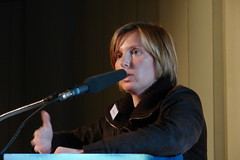
teri rueb
Originally uploaded by mobilemusicworkshop.
Posted by Ronald Lenz at 14:00 0 comments
Location: WAAG Nieuwmarkt
9.30 - 13.00 Registration desk open at WAAG
10.30 – 13.00 Welcome and keynotes:
• 11.00 Welcome by steering committee
• 12.00 Keynote: Teri Rueb
13.00 Performance on the way from Waag to STEIM:
• Cathy van Eck – “Hearing Sirens: A project for mp3-players with portable horn-loudspeakers
Posted by k at 12:20 0 comments